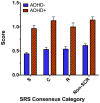Examining autistic traits in children with ADHD: does the autism spectrum extend to ADHD?
- PMID: 21108041
- PMCID: PMC3123401
- DOI: 10.1007/s10803-010-1135-3
Examining autistic traits in children with ADHD: does the autism spectrum extend to ADHD?
Abstract
We examined to what extent increased parent reports of autistic traits in some children with Attention Deficit Hyperactivity Disorder (ADHD) are the result of ADHD-related symptoms or qualitatively similar to the core characteristics of autism spectrum disorders (ASD). Results confirm the presence of a subgroup of children with ADHD and elevated ratings of core ASD traits (ADHD(+)) not accounted for by ADHD or behavioral symptoms. Further, analyses revealed greater oppositional behaviors, but not greater ADHD severity or anxiety, in the ADHD(+) subgroup compared to those with ADHD only. These results highlight the importance of specifically examining autistic traits in children with ADHD for better characterization in studies of the underlying physiopathology and treatment.
Figures



References
-
- Abikoff HB, Jensen PS, Arnold LL, Hoza B, Hechtman L, Pollack S, et al. Observed classroom behavior of children with ADHD: relationship to gender and comorbidity. Journal of Abnormal Child Psychology. 2002;30:349–359. - PubMed
-
- Achenbach T, Edelbrock C. Manual for the Child Behavior Checklist and Revised Child Behavior Profile. University of Vermont, Department of Psychiatry; Burlington, VT: 1983.
-
- American Psychiatric Association. Diagnostic and statistical manual of mental disorders. 4th. Washington, D.C.: American Psychiatric Association; 1994.
-
- Bagwell CL, Molina BS, Pelham WE, Jr, Hoza B. Attention-deficit hyperactivity disorder and problems in peer relations: predictions from childhood to adolescence. Journal of the American Academy of Child and Adolescent Psychiatry. 2001;40:1285–1292. - PubMed
-
- Biederman J, Faraone SV, Mick E, Williamson S, Wilens TE, Spencer TJ, et al. Clinical correlates of ADHD in females: findings from a large group of girls ascertained from pediatric and psychiatric referral sources. Journal of the American Academy of Child and Adolescent Psychiatry. 1999;38:966–975. - PubMed
Publication types
MeSH terms
Grants and funding
LinkOut - more resources
Full Text Sources
Medical

